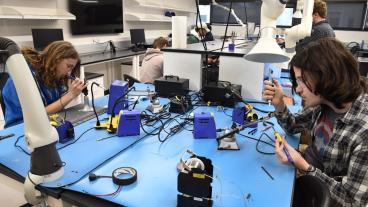New Nature article outlines how research led at Mines achieved breakthrough in our understanding of neutrinos
The team used “tabletop-scale” precision measurements of radioactive decay to uncover insights about fundamental particles
A team of researchers, led in part by Colorado School of Mines Postdoctoral Researcher Joseph Smolsky and Associate Professor of Physics Kyle Leach, along with a large local undergraduate and graduate student team, has achieved a breakthrough in understanding the elusive nature of neutrinos—one of the universe’s most mysterious particles. Their findings, to be published in the journal Nature's Feb. 13, 2025 issue, provide the first direct experimental constraints on the spatial extent, or "quantum size," of a neutrino using a novel precision measurement technique.
Unlike traditional particle physics experiments that rely on massive high-energy colliders, the research is part of the BeEST (pronounced “beast”) experiment, an international collaboration that takes a different approach. The team uses “tabletop-scale” precision measurements of radioactive decay to uncover new insights about fundamental particles. By embedding radioactive beryllium atoms into superconducting sensors thinner than a human hair, the researchers can track the decay process with unprecedented accuracy.

“Our work is a prime example of how small-scale, high-precision experiments can complement the discoveries made at large particle colliders,” said Leach. “By precisely measuring the behavior of lithium atoms produced in the decay of beryllium, we gain direct access to quantum properties of neutrinos—particles that are notoriously difficult to detect.”
Neutrinos are the second most abundant form of matter in the universe yet among the least understood. Because they rarely interact with other particles, studying them has remained a formidable challenge. The BeEST experiment overcomes this obstacle by leveraging quantum entanglement: when a lithium nucleus and a neutrino are simultaneously produced in radioactive decay, measuring the lithium nucleus with extreme precision allows researchers to infer properties of the neutrino that would otherwise be inaccessible.
With just one superconducting sensor measuring for 20 hours, the researchers have improved upon all previous experimental limits on neutrino spatial extent. These results offer crucial insights for theoretical models of neutrino behavior and pave the way for future studies on subatomic particles.
“This is just the tip of the iceberg,” Leach said. “Our findings could have far-reaching implications, from refining the standard model of particle physics to improving methods for detecting neutrinos from nuclear reactors and astrophysical sources. We are excited for what comes next.”
The BeEST experiment is a collaborative effort involving Mines’ Physics Department and Quantum Engineering and Nuclear Engineering programs, with major contributions from Lawrence Livermore National Laboratory, Pacific Northwest National Laboratory, TRIUMF (Canada), and institutions across Europe. The work is supported by the U.S. Department of Energy and the Gordon and Betty Moore Foundation.
The full study is available in the February 13, 2025, issue of Nature.




